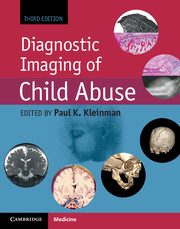Book contents
- Frontmatter
- Dedication
- Contents
- List of Contributors
- Editor’s note on the Foreword to the third edition
- Foreword to the third edition
- Foreword to the second edition
- Foreword to the first edition
- Preface
- Acknowledgments
- List of acronyms
- Introduction
- Section I Skeletal trauma
- Section II Abusive head and spinal trauma
- Section III Visceral trauma and miscellaneous abuse and neglect
- Chapter 22 Visceral trauma
- Chapter 23 Miscellaneous forms of abuse and neglect
- Section IV Diagnostic imaging of abuse in societal context
- Section V Technical considerations and dosimetry
- Index
- References
Chapter 23 - Miscellaneous forms of abuse and neglect
from Section III - Visceral trauma and miscellaneous abuse and neglect
Published online by Cambridge University Press: 05 September 2015
- Frontmatter
- Dedication
- Contents
- List of Contributors
- Editor’s note on the Foreword to the third edition
- Foreword to the third edition
- Foreword to the second edition
- Foreword to the first edition
- Preface
- Acknowledgments
- List of acronyms
- Introduction
- Section I Skeletal trauma
- Section II Abusive head and spinal trauma
- Section III Visceral trauma and miscellaneous abuse and neglect
- Chapter 22 Visceral trauma
- Chapter 23 Miscellaneous forms of abuse and neglect
- Section IV Diagnostic imaging of abuse in societal context
- Section V Technical considerations and dosimetry
- Index
- References
Summary
Introduction
Although neglect and sexual abuse constitute the majority of reports of child maltreatment, these conditions are only occasionally manifested by abnormalities on diagnostic imaging studies. These children, along with those suffering uncommon patterns of abuse, may evidence striking and bizarre alterations on imaging studies. Furthermore, since they often have real or factitious signs and symptoms suggesting somatic disorders, children may undergo various radiologic examinations that can obscure, rather than clarify, the true nature of the process. The radiologist must be familiar with the clinical complexities as well as the unusual imaging manifestations of these assorted forms of child maltreatment, and may be the first medical professional to suggest the correct diagnosis.
The various forms of abuse and neglect to be discussed in this chapter cannot be viewed as isolated entities. Although one type of pathology may predominate, there is frequently substantial overlap between conditions, and care should be taken to avoid simple and artificial distinctions between complex and closely related entities.
Abuse of children with disabilities and other special needs
Background
Children with special needs are defined broadly as a group that includes individuals who have chronic physical, developmental, behavioral, or emotional conditions who require health-related services beyond that required by children generally (1, 2). In 2010, the World Health Organization estimated that 1.86 billion children were living with a disability (3). There is a general consensus that the abuse of children with disabilities and special needs constitutes a major global public health problem (4–16), although this view has occasionally been questioned (17). Factors predisposing to abuse include societal stigma and discrimination, negative traditional beliefs and ignorance within communities, lack of social support for caregivers, the type of impairment, and heightened vulnerability due to the need for increased care and medical attention (4). These factors combine to generate an overwhelmed feeling in caretakers and an inability to cope with the special needs and supervision required in these cases.
- Type
- Chapter
- Information
- Diagnostic Imaging of Child Abuse , pp. 608 - 630Publisher: Cambridge University PressPrint publication year: 2015



